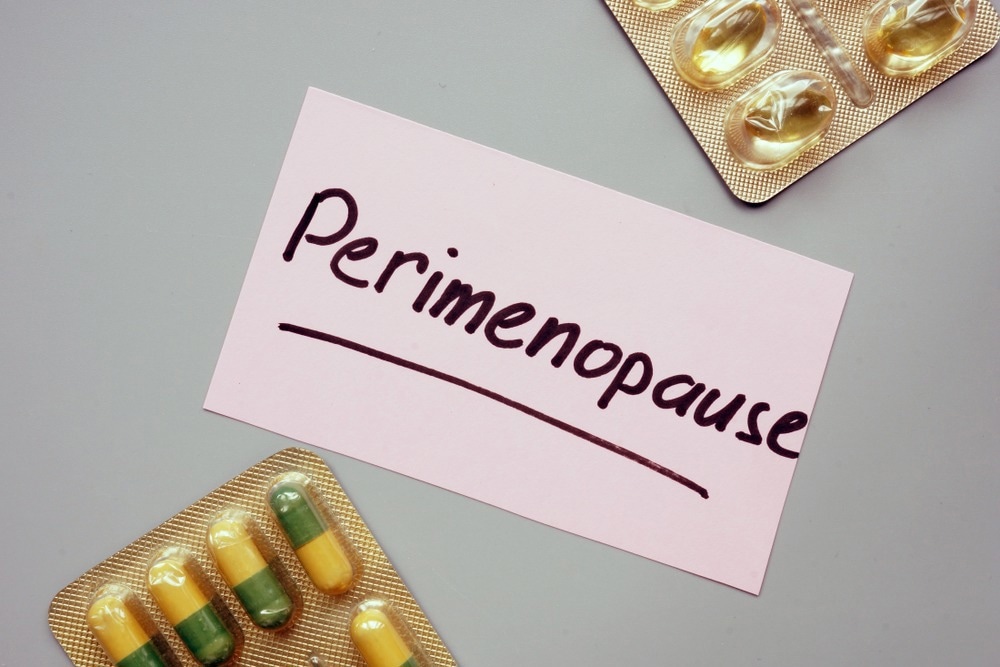Perimenopause and estrogen
Symptoms and onset of perimenopause
Managing the symptoms of perimenopause
References
Further reading
Perimenopause means “around menopause” and refers to the transition period before menopause and cessation of menstruation, which can last for several years. From when periods begin until perimenopause, the period is termed premenopause, and once menopause is completed, it is known as postmenopause.

Image Credit: Jack_the_sparow/Shutterstock.com
Perimenopause typically begins around age 45 and is associated with sweeping and fluctuating changes in hormone levels, frequently causing a variety of physical and psychological negative side effects such as depression, osteoporosis, and heart disease.
Menopause is diagnosed once a woman has not had a menstrual period in the preceding 12 months, and according to the World Health Organization (WHO), perimenopause includes the period before and the first year after menopause, as periods are often irregular and sparse at this stage of life and so providing a firm end date is difficult.
Perimenopause and estrogen
During perimenopause, estrogen levels are typically 20-30% higher than during premenopause and fluctuate much more widely. During premenopause, ovulation is tied to estrogen and progesterone levels in the body, where high estrogen induces luteinizing hormone activation and then egg release.
If the woman does not become pregnant, progesterone falls, and menstrual bleeding occurs. This cycle repeats every month until the onset of perimenopause, where estrogen levels become much more irregular and vary throughout the month. This may cause menstrual cycles to lengthen or shorten and become irregular, and can also cause menstruation without successful prior ovulation, i.e., no egg is released. Most symptoms associated with perimenopause directly result from estrogen dysregulation and subsequent dysregulation of downstream hormones.
Symptoms and onset of perimenopause
Each individual experiences perimenopause differently, though the transition lasts between three to four years on average. Menstrual bleeding may continue throughout this period and usually becomes increasingly irregular until cessation.
Though most women experience negative symptoms associated with perimenopause, the majority are mild, with around 20% of individuals reporting moderate to severe symptoms according to international rating scales. Changes in hormone levels can also indirectly lead to an increased risk of more serious conditions such as heart disease, specifically owing to arterial narrowing when estrogen is low.
One of the most commonly reported symptoms of perimenopause is hot flashes, occurring in around 45-85% of women, depending on the study source. The actual mechanism behind hot flashes is not yet completely understood but is related to low estrogen levels causing sensitization of the hypothalamus. In response to warm temperatures, the overly sensitive hypothalamus may respond by inducing a hot flash to cause sweating in an attempt to ultimately cool the body.
Further symptoms include excessive night sweating, difficulty sleeping, fatigue, migraines, loss of libido, mood changes with the risk of developing anxiety, weight gain, and vaginal dryness. Vaginal dryness and vaginal atrophy are also the results of low estrogen levels. In the case of the latter, thinning and inflammation of the vaginal walls bring potential discomfort during sex and a host of incontinence issues. The use of lubricants and intravaginal estrogen can ease vaginal dryness and atrophy, though disruption of an individual’s sex life can have other lasting psychological issues.

Image Credit: YAKOBCHUK VIACHESLAV/Shutterstock.com
Depression is widely reported amongst women going through perimenopause, either as a direct result of changes and fluctuations in hormone levels, due to other associated negative side effects, owing to the prospect of never having any more children or a combination of these factors.
Studies suggest that other changes in brain function are also evident during perimenopause. For example, Weber et al. (2014) conducted a longitudinal study of women throughout perimenopause, finding that a decrease in memory, verbal learning, verbal memory, and fine motor speed was evident, particularly during the final 12 months following the last menstrual period.
The study was able to eliminate depression, anxiety, and sleeping problems associated with perimenopause as the root cause of cognitive decline, suggesting that hormonal changes occurring at this time may also influence brain function. These changes are not thought to be permanent and may occur transiently in line with fluctuating hormone levels, commonly reported as “brain fog” by women experiencing this symptom.
As discussed, stresses and anxieties related to the loss of the ability to bear children frequently occur during perimenopause, along with other probable stresses occurring at this stage of life, such as caring or grieving for parents, older children leaving home, and grandchildren being born, thus pushing them into an older generational category.
What is the Perimenopause? | Nuffield Health
Various psychotherapeutic strategies with a focus on acceptance and adaptation may be beneficial for those struggling with these aspects of perimenopause, and studies suggest that those employing stress relief strategies such as meditation or exercise may experience improved mood.
Managing the symptoms of perimenopause
A number of hormone therapies have shown success in alleviating the symptoms of perimenopause, often reporting improved mood, sleep quality, and libido, with reduced depression. Estrogen analogs are generally employed during hormone therapy and can be administered in pill form for convenience.
Health issues related to perimenopause, such as arterial narrowing, may also be lessened using hormone therapy, where estrogen and other hormonal levels are normalized and better regulated. However, long-term studies are in the early stages, and it has yet to be demonstrated that any alleviation of heightened risk lasts into the postmenopausal period.
References
Further Reading
Last Updated: Dec 20, 2022